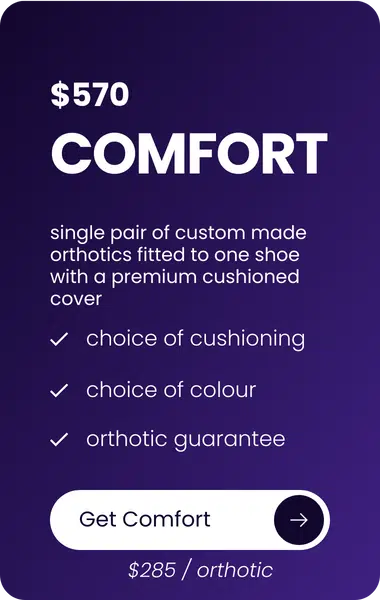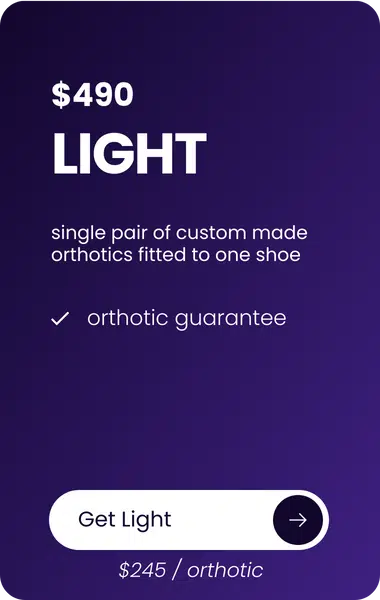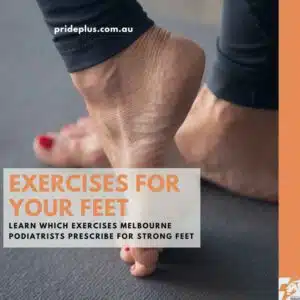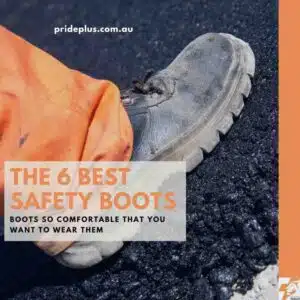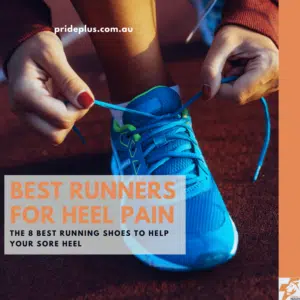If you need a pair of orthotics for flat feet to provide arch support or reduce the pain you should skip the visit to the supermarket aisle to see Dr Scholl.
Your feet will thank you.
Orthotics for flat feet have come a long way since Dr Scholl first started crafting supports that are now produced en masse and can be picked up at your local Woolies.
But first, what is an orthotic? (and let’s define flat feet)
Alright, a couple of things for us to be clear on so we’re both on the same page with what we’re discussing:
- Orthotics are those shoe inserts that sit under your foot and comfortably redistribute pressure or load away from tired, sore or injured areas.
- Flat feet (except for a rare condition known as adult-acquired flat foot) are healthy and flexible feet with a lower arch than the norm.
So when you need orthotics for flat feet, you need something that can comfortably take the pressure or load away from sore areas, or at risk of becoming sore.
Common problems for flat feet
Not everyone with flat feet gets pain but there are a few common areas and injuries:
- Heel pain (plantar fasciitis).
- Arch pain (tibialis posterior tendinopathy).
- Ball of foot pain (bunions or turf toe).
It’s vitally important for your injury management or prevention that your orthotics for flat feet will work. That’s where a podiatrist-prescribed orthotic comes in (and Dr Scholl goes out).
How orthotics for flat feet work
I’m going to get a little technical here talking about how orthotics for flat feet work.
I trust that by making it this far, you’re already across why they’ll work (or maybe this might help convince you). The how is where things get interesting to a foot dork like me.
Let’s take the most common injury that affects a flat foot. Plantar fasciitis (a sharply painful injury under the heel). For a flat foot to get plantar fasciitis it means that the plantar fascia has been pulled too far and too often as your foot steps onto the ground.
Understanding plantar fasciitis
Every time your arch lowers, your plantar fascia is strained. Now usually, the plantar fascia loves this kind of strain, but like everything, it can say “enough is enough” and become overworked and sore. Thus, plantar fasciitis.
So, an orthotic for flat feet suffering from plantar fasciitis works by applying enough (comfortable) force to the inside of the arch to allow it to lower, but to not go as low as without it. Where it becomes tricky is you can’t just push up directly under the arch as this leads to a locked-up big toe joint and instead of feeling nice and comfortable, your foot will turn out and twist away which can cause new problems at the ball of the foot, ankle and even your knee.
In this scenario, there will be an optimal zone on your foot where your orthotic can push to allow your arch to lower comfortably but not too low. You’ll also then move to push down through your forefoot and the big toe to reduce the risk of any problems happening elsewhere.
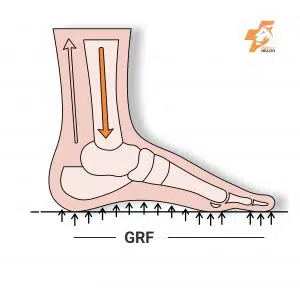
In the image above, you reading from left to right, you have to push on the foot under first 6 arrows. If you press up from the 7 arrow onwards you run the risk of locking the big toe and causing more problems.
It’s technical, grounded in sexy physics (oh yeah kinetics and kinematics are my jam) and the difference between a flimsy bit of gel or rubber under your foot and getting an orthotic that works for you.
So what should you do to get orthotics for flat feet (that work for you)
I’m as biased as they come – you should come to see your podiatrists at our PridePlus Health clinics!
But realistically, I get that you might not be close to us, you could be reading this in Sydney, New York or Manilla. And that’s a fair trek to come to see us friendly pods down in Victoria.
And then there’s the cost of orthotics too. Not every one of us has the ability right now to get a pair of orthotics (despite their surprising fall in price due to technology like 3D printing). So as a starting point, if you’re local to us we’d love to help you.
If you’re a little further away then finding the best podiatrist in your area is worth a shot. There’s also the role of exercise therapies that you can do as well to help your flat feet.
Before you go…
Thanks for sticking through and learning all about orthotics for flat feet and how they can help you. While you’re here, would it be impossible for you to check out more orthotic & flat-footed content to help you?
You can learn about arch pain or the best thongs in Australia. Flat feet need much more than just a flat rubber sandal and there are a bunch of quality options for your feet. Also, why we have an orthotic guarantee to give you the confidence in your new devices.
About the author

Pascoe Vale podiatrist and La Trobe University educator Tim Mulholland is a self-confessed foot dork who wants to help you live the best life on your feet. He doesn’t have anything personal against Dr Scholl (he respects his elders!). If you’ve worn Dr Scholl insoles in the past and been happy with them that’s great too.



